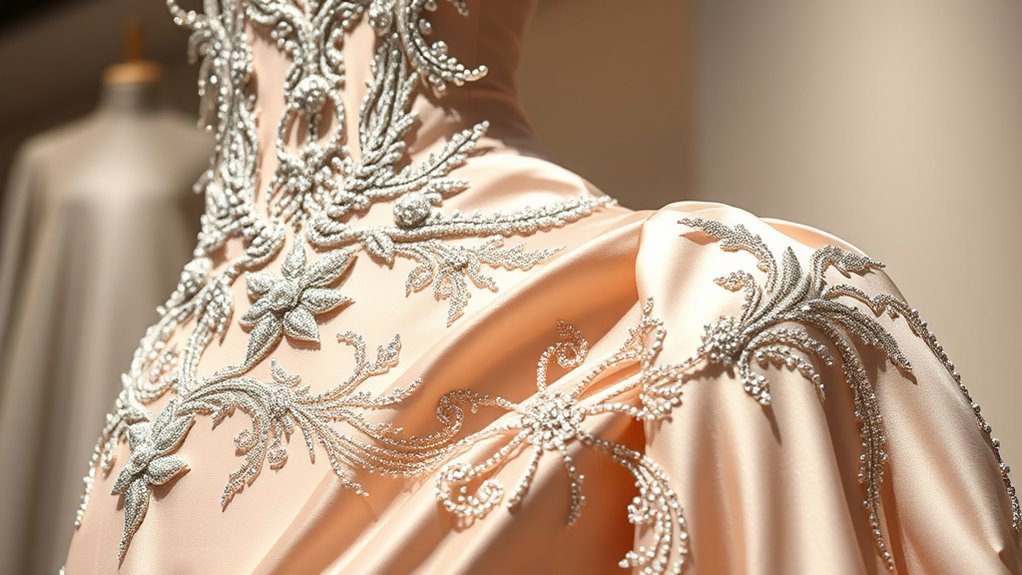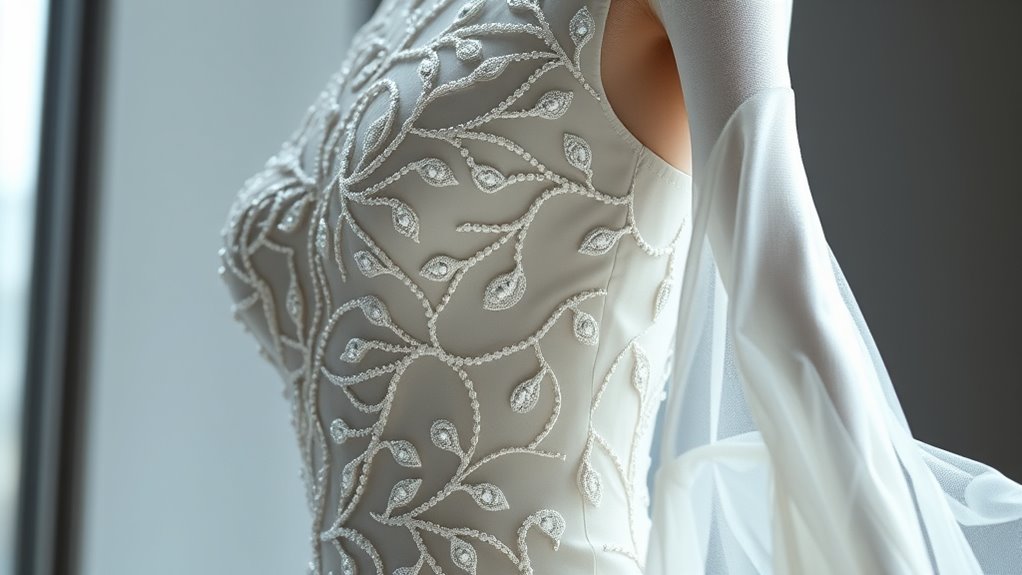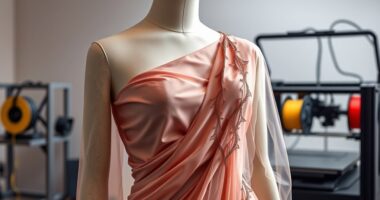In haute couture, protecting your design innovations involves a combination of legal measures and meticulous supply chain management. You can register copyrights, trademarks, and design patents to secure unique features, while establishing confidentiality agreements with collaborators guarantees your ideas stay private. Carefully controlling sourcing and production limits unauthorized reproductions, strengthening your brand’s exclusivity. If you want to learn about the strategies that help maintain the integrity and prestige of couture designs, keep exploring how these protections work together to safeguard your creative work.
Key Takeaways
- Haute couture brands use legal tools like copyrights, trademarks, and design patents to protect their unique creations.
- Strict supply chain management ensures secrecy and reduces the risk of unauthorized copying or leaks.
- Confidential collaborations with designers and celebrities are governed by nondisclosure agreements to safeguard design ideas.
- Legal actions against counterfeiters reinforce intellectual property rights and maintain brand exclusivity.
- A combined approach of supply chain oversight and legal protections sustains the creative integrity and prestige of haute couture.

Have you ever wondered how high-end fashion houses protect their one-of-a-kind designs? It’s a complex process that involves more than just creating stunning pieces; it’s about safeguarding the innovation behind each garment. When a luxury brand develops a new couture piece, they need to ensure that their exclusive design can’t be easily copied or stolen. This begins with a close look at their supply chain, which is often highly curated and carefully managed to prevent leaks. From sourcing rare fabrics to employing skilled artisans, every step is designed to maintain secrecy and control over the final product. By tightly managing their supply chain, brands can reduce the risk of unauthorized reproductions and ensure their designs stay unique.
Brand collaborations play a significant role in this protection strategy. When a high-end house partners with another designer, celebrity, or even a luxury retailer, they often formalize agreements that include strict confidentiality clauses. These collaborations are carefully negotiated to guard the originality of the designs and prevent intellectual property theft. When you’re involved in a brand collaboration, you need to understand that your shared design ideas are protected by legal frameworks, such as licensing agreements or non-disclosure contracts. These legal tools act as a shield, ensuring that the innovative elements you contribute aren’t leaked or copied by third parties. It’s a way for brands to expand their influence without sacrificing the integrity of their creations.
Moreover, high-end fashion houses leverage intellectual property rights—mainly copyrights, trademarks, and design patents—to defend their unique styles. They register their logos, signature motifs, and specific design features to establish clear ownership. When someone attempts to reproduce a couture gown or a signature pattern without permission, these legal protections make it easier to take action against infringement. It’s not just about having a beautiful design; it’s about establishing a legal claim that says, “This belongs to us.” This legal framework, combined with a well-managed supply chain and strategic brand collaborations, creates a robust defense against counterfeiters and imitators. Additionally, understanding the importance of flushing mechanisms and their design efficiency can inspire brands to incorporate innovative features that further distinguish their products.
In essence, protecting couture designs involves a blend of meticulous supply chain management, strategic legal protections, and carefully negotiated collaborations. As a fashion enthusiast or industry insider, understanding these layers of defense reveals how much effort goes into maintaining the exclusivity and artistry of high fashion. It’s a continuous process that ensures the creative vision remains uniquely theirs, reinforcing the value and prestige of luxury couture.
Frequently Asked Questions
How Long Do Copyright Protections Last for Haute Couture Designs?
In the fashion industry, you might wonder how long copyright protections last for designs. Generally, copyright lasts for the creator’s lifetime plus 70 years, but this varies by country. For haute couture, intellectual property rights can be complex, as designs often aren’t fully protected under copyright law. It’s essential to understand these limits to safeguard your innovations and prevent unauthorized copying in the fast-paced fashion world.
Can Digital Designs of Haute Couture Be Copyrighted or Trademarked?
Oh, of course, digital designs are unworthy of protection—said no one ever. You can absolutely register your digital haute couture designs through digital design registration, securing copyright or trademark rights. While haute couture patents are rare, they can cover unique innovations. Protecting digital fashion is vital, so don’t hesitate to pursue appropriate intellectual property rights. After all, your cutting-edge designs deserve the same level of safeguarding as their physical counterparts.
What Legal Actions Are Available Against Design Counterfeiting in Fashion?
When facing design infringement, you have several legal recourse options. You can file a lawsuit for copyright or trademark infringement, which helps protect your original designs from counterfeiting. Additionally, customs enforcement can seize counterfeit goods at borders. You might also pursue cease-and-desist orders or negotiate settlements. These actions help safeguard your creative work, and acting promptly can prevent further damage caused by design infringement in the fashion industry.
How Do International IP Laws Affect Haute Couture Protection?
You should understand that international IP laws influence how you protect haute couture designs by enabling cross-border enforcement. International treaties like the Berne Convention and TRIPS agreement help guarantee your rights are recognized in multiple countries. These treaties facilitate cooperation among nations, making it easier to prevent counterfeiting and enforce your design protections worldwide. However, differences in national laws can still pose challenges, so staying informed and working with legal experts is essential.
Are There Specific IP Challenges Unique to Haute Couture Compared to Ready-To-Wear?
Think of haute couture as a finely woven tapestry, where fabric secrecy and custom tailoring are the threads that make it unique. Unlike ready-to-wear, you face IP challenges like protecting intricate designs and maintaining exclusivity. Your creations often involve one-of-a-kind craftsmanship, making theft or imitation easier to spot but harder to prevent without robust legal protections. These challenges demand tailored IP strategies to safeguard your artistic vision.
Conclusion
By understanding the importance of intellectual property, you can safeguard your design innovations and stand out in the world of haute couture. Don’t let others steal your thunder or ride your coattails—protect your creative vision fiercely. Remember, in the fashion industry, a stitch in time saves nine. Staying vigilant and proactive guarantees your unique creations remain yours alone, allowing your artistry to flourish without fear of imitation. Keep your designs as exclusive as a diamond in the rough.










